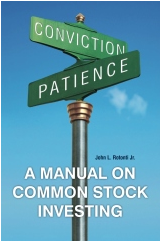“It is extraordinary to me that the idea of buying dollar bills for 40 cents takes immediately with people or it doesn’t take at all. It’s like an inoculation. If it doesn’t grab a person right away, I find that you can talk to him for years and show him the records, and it doesn’t make any difference. They just don’t seem to grasp the concept, simple as it is.”
— Warren Buffett, The Superinvestors of Graham-and-Doddsville, 1984
It has been thirty years since Warren Buffett referred to value investing as an “inoculation” and his sentiment appears to be just as valid today. The ease of access to high quality information is far greater for investors today but so is the constant noise from the hopelessly short term oriented financial media. If a new investor is to stand a chance against the risk of becoming a speculator, he or she needs to have a firm grounding in value investing concepts and a road map for obtaining further knowledge and avoiding the noise.
John Rotonti presents beginning investors with an easily understandable guide to value investing in A Manual on Common Stock Investing. All writers who attempt to explain investing to beginners must strike the right balance between conveying the basic principles in a manner that stresses the fact that these concepts might appear simple but are not simplistic. Otherwise, it is all too easy for new investors to get lulled into overconfidence. Mr. Rotonti succeeds in presenting the basic formulation required for success while stressing the need for further reading to develop an aspiring investor’s circle of competence.
The book is divided into seventeen brief chapters outlining the basic concepts a beginning investor must learn before allocating any capital. For example, Chapter 13 covers the topic of compound interest which is one of the most powerful but least understood concepts among the general population. It is very likely that if high school graduation required mastery of compound interest, millions of Americans would be far more prudent when it comes to savings as well as debt. Mr. Rotonti covers this subject well using examples that should resonate with readers who were previously unfamiliar with the concept. Since the pursuit of compounding at attractive rates of return is the driving force behind all enterprising investing, it is critical for readers to understand the massive difference in the end result of a lifetime of 10% returns compared to 7% returns.
While the book does encourage readers to pursue investing if they have a passion for the process, Mr. Rotonti urges readers who do not have the time or inclination to direct their money into index funds so they at least earn the returns offered by the overall market. One of the most significant risks facing investors with only a passing interest in the process is that overconfidence could lead to a concentrated portfolio that performs very poorly or even results in the permanent loss of a material amount of capital. Mr. Rotonti devotes a brief chapter to the importance of avoiding permanent losses of capital and reminds readers of the less than intuitive math required to recover from significant losses. Diversification via broad indexing is nothing to be ashamed of for the non-enterprising investor and, over an investing lifetime, should provide attractive results while minimizing the risk of permanent losses.
Writing a book with the intent of being one of the first exposures for readers into the world of investing is not an easy task. The balance between encouragement and caution is not necessarily easy to achieve. Many of the concepts advocated by value investors like Warren Buffett seem so “obvious” to novices that overconfidence can quickly develop. Mr. Rotonti provides a recommended reading list for those who would like to pursue the subject further.
After finishing this book, most readers should have a good sense of the importance of avoiding losses, the power of compounding, and the basic language and concepts used by value investors. Based on this knowledge, the reader can determine whether to proceed with an “enterprising” strategy or opt for indexing. We would recommend this book for beginning investors curious about whether an active role suits their interests, skills, and temperament.
Disclosure: The Rational Walk received a complimentary review copy of the book from the author.

